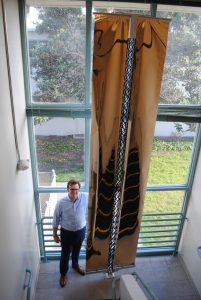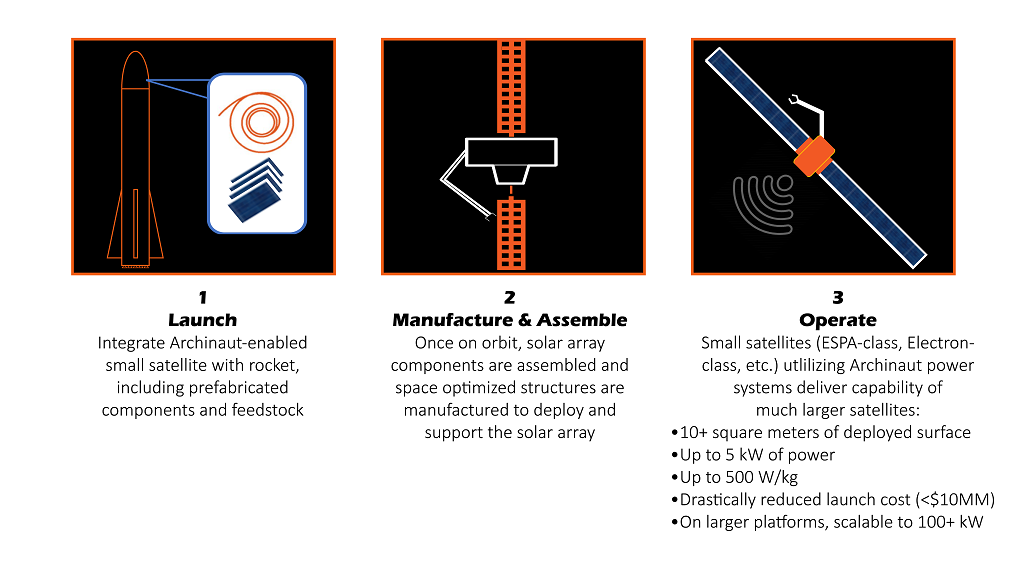Made In Space started building its Archinaut system a couple of years ago – essentially a 3D printer with a robotic arm capable of building in the vacuum of space. The purpose of the machine was to be able to build and repair satellites in space, creating larger and more complex systems than could be launched from Earth. But it’s small satellites that Archinaut’s technology is enabling currently – small satellites with the power of large ones.
Currently, small satellites are restricted to one kilowatt of power or less, but Made In Space is developing a power system that can provide up to five kilowatts of solar power, enabling the small satellites to provide large satellite capability.
“These systems enable power intensive payloads to be deployed to space at a fraction of the cost of larger satellites, with no sacrifice in power provisioning,” said Andrew Rush, CEO of Made In Space.
Archinaut-based solar array systems use space-manufactured structures and robotically assembled solar cell blankets to provide up to 20 square meters of solar array for small satellites that launch from ESPA rings or small launch vehicles.
“Despite advances in avionics and payload packaging, small satellites provide less capability per kilogram than their larger brethren because small satellites are power constrained. This often prevents power intensive science, remote sensing, communications, and defense payloads which otherwise fit,” Rush said. “Deploying these power intensive payloads on small satellites is game changing because these platforms costs an order of magnitude less to build and launch and can be fielded much more rapidly than 1,000+ kilogram satellites.
“The technology risk is very low. The core additive manufacturing technology currently operating in space and the extended structure manufacturing and robotic system hardware demonstrated in thermal vacuum chambers simulating the LEO environment.”
Made In Space’s extended additive manufacturing technology (ESAMM) is capable of manufacturing structures much longer than the machine itself, and last year the company set a Guinness World Record for the longest 3D printed part, which was 37.7 meters long. ESAMM was also successfully operated in a thermal vacuum chamber that simulated a Low Earth Orbit environment.
“We continue to develop these technologies, planning more complex thermal vacuum and laboratory tests focusing on more complex and autonomous manufacturing and assembly operations,” said Rush.
Archinaut’s power system is capable of providing up to five times the power of state of the art systems for small satellites by launching the system with raw material and tightly packed solar arrays rather than folded up booms and complex deployment mechanisms. On orbit, Archinaut manufactures the core array lattice structures and integrates solar array blankets robotically, physically and electrically, completing the solar array wing.
“Due to the volume and mass efficiencies of manufacturing the structure, a small satellite such as a 150 kg ESPA-class satellite could be deployed with 5 kW of power,” said Rush. “Today, that kind of power is only available on 1,000+ kg satellite buses launching on rockets costing tens of millions of dollars.”
Archinaut’s power system will enable many large satellite applications on small satellites. It can also operate as a standalone system integrated into larger satellite buses, making larger systems more efficient. Preliminary studies indicated that a 500-kW Archinaut power system using modern solar cell blankets requires 2,000 m² of solar array surface area and has a system mass of 1,000 kg – more than an order of magnitude less mass than systems currently on orbit. The International Space Station’s eight solar array wings, in contrast, have an area of about 2,500 m² with a system mass of 65,000 kg.
“Because the Archinaut system uses in space manufacturing and robotics, the same core technology will be useful for a range of spacecraft missions,” said Rush. “It can also be used for a range of impactful applications beyond power systems, such as creating large apertures or spacing out sensors from one another.”
Discuss this and other 3D printing topics at 3DPrintBoard.com or share your thoughts below.
[Images: Made In Space]
Subscribe to Our Email Newsletter
Stay up-to-date on all the latest news from the 3D printing industry and receive information and offers from third party vendors.
Print Services
Upload your 3D Models and get them printed quickly and efficiently.
You May Also Like
3D Printing News Briefs, January 15, 2026: Project Call, Sports Medicine, Aluminum Alloy, & More
In today’s 3D Printing News Briefs, America Makes announced the winners of a $1.1 million Project Call, Austal USA named a new Vice President for Business Development and External Affairs,...
US Army Awards Contract to Phillips Federal for Containerized WAAM Factories
Everything that the U.S. Army has been doing with additive manufacturing (AM) over the last year or so suggests that the branch is getting serious about deployable production systems. One...
Top 10 3DPrint.com Stories of 2025: Kickstarter, Consumer Goods, Bankruptcy, & More
As Vanesa Listek wrote, last year was a major turning point for additive manufacturing (AM), as the industry is working to sort itself out. Customers want proven use cases and...
3D Printing News Briefs, January 3, 2026: F-15 Replacement Part, Ice Trees, & More
Happy New Year! We’ve got an abbreviated 3D Printing News Briefs for you today, so we can all enjoy our holiday weekend but still keep up on the industry’s news....
































